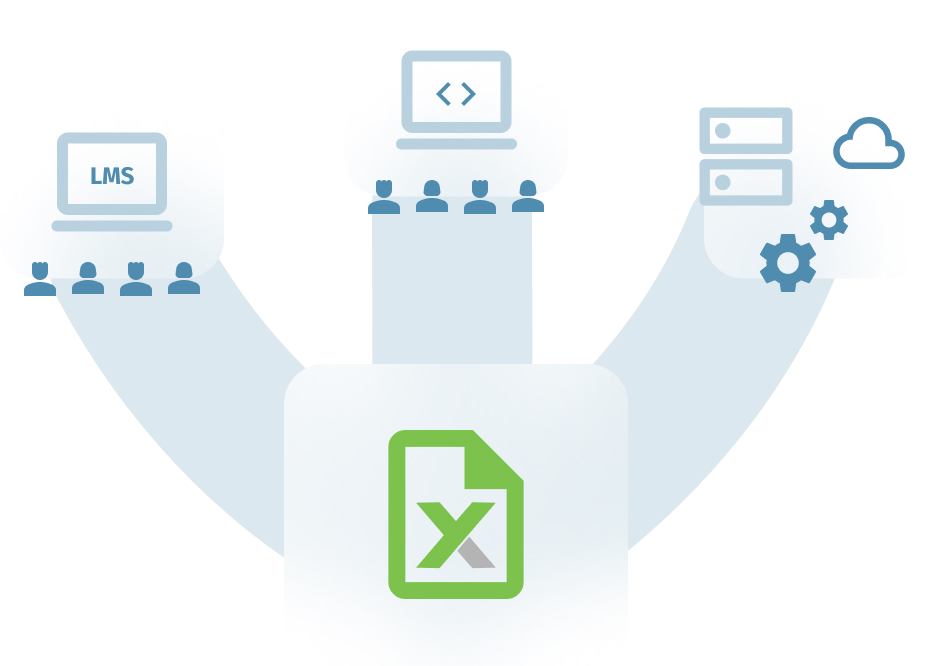As reskilling and upskilling employees become more integral to business strategy, the importance of a well-designed Learning and Development tech stack cannot be overstated. Personalized and timely learning requires a centralized content management system to ensure efficient storage, access, and application of content throughout the learning environment. The missing piece of the puzzle for L&D is the implementation of such a system, which is vital to providing flexible and relevant content delivery.
“I estimate we have cut content development time by 66% simply by being able to easily reuse what’s already been created.” - Allina Health
The LXP was Learning's Answer to Netflix
Think back to when the primary tool for L&D was the Learning Management System (LMS), later complemented by the Learning Experience Platform (LXP). Though groundbreaking in their era, these systems tended to function in isolation. The LXP, sometimes dubbed the "learning's answer to Netflix," granted learners greater independence but often lacked direction. This could lead learners down the wrong path—imagine diving into lessons on typewriter maintenance when the company focus is shifting to digital document creation, for example. 
But the answer isn't to discard these platforms. They still bring a wealth of benefits. What's key is to weave them together, making sure learners can tap into the right content at the exact moment it’s needed. Today, most learning happens in real-time on the job, calling for resources like knowledge articles, help documents, and troubleshooting guides.
To manage the delivery of such diverse content across different platforms and learning methods, L&D requires a central hub. A Learning Content Management System (LCMS), such as Xyleme can be the perfect conductor for this intricate orchestration of content sharing.
Smooth the Learning Path with Centralized Content
With unprecedented strategy shifts across every industry, it’s crucial to have a unified approach to learning and skill development. People must acquire knowledge smoothly, no matter the platform or method of delivery.
Ensuring a unified learning and skills framework isn't just a goal—it's essential. A well-connected ecosystem offers a smooth knowledge-gaining experience, regardless of platform or method. But this ideal scenario can be disrupted by piecemeal content. When information is scattered or inconsistent, it can lead to gaps in knowledge, resulting in a less streamlined learning journey and potentially reducing the impact of a learning program.
The challenges posed by inconsistent content aren't limited to simple bumps in the road. For learners, facing mismatched information can lead to uncertainty, reduced motivation, and even skepticism about the accuracy of the content. This might mean extra hours double-checking information, drawing them away from their main objective: learning.
In fields where strict compliance or accuracy is essential, such inconsistencies could open the door to significant mistakes. Centralization is the remedy to this challenge.


A centralized content repository acts as a consistent, reliable source for all learning materials. Whether someone's accessing a module from a computer in New York or on a mobile phone in Tokyo, the learner receives the version of the content they need with their regional differences.
The ROI of Centralized Content Management
In addition to the real impact of de-centralized content on employees and the enterprise, many organizations also overlook the fact that L&D content is not just a function of maintaining and developing the skills for the right people at the right time. With the right content strategy, enabled by the right content, enterprise L&D content teams have the potential to drive significant return on investment (ROI).
The benefits of a tech stack that enables an enterprise content strategy can include:
- Increased productivity and reduced resource requirements
- Improved employee experience
- Improved customer experience, outcomes, and profitability
- Increased learner engagement and content personalization
- The ability to grow in scope and scale
When content is centralized, organizations can manage, tag, and keep track of versioning in one place, eliminating the need to search multiple LMSs, file shares, or even individual laptops, for the most up-to-date content. In fact, data shows that Fortune 500 companies lose at least $31.5 billion a year due to a lack of internal knowledge sharing.
The ability to store, maintain and, critically, maintain your L&D content is a core component of meeting your overall business goals.
Organizations that move to Xyleme report:
- A 30% reduction in content development time
- A 50% reduction in content maintenance
- A 4X increase in content engagement rates
"Xyleme is easy to use and allows us to focus on making the content better. It has been a terrific time and cost savings for us." - Ford
The Right Content, Tagged for the Right Learners
Content's worth is deeply tied to how easily it can be accessed. As the volume of content grows, tagging takes center stage in ensuring content gets to the right learners when they need it.
Learners can easily tap into a broad spectrum of content without jumping from one platform to another. It simplifies the hunt for information from various corners, speeding up the learning process.
The ability to deliver on the promise of search means your content needs to be tagged properly so it can be delivered accurately.
 Tagging labels content with relevant keywords, making it straightforward to pull up. Here, Artificial Intelligence (AI) offers a helping hand. AI can quickly analyze large amounts of content and suggest tags. Yet, as digital learning becomes more intricate, there's a balance to strike between AI suggestions and human decisions. While AI is great at offering initial tags, human judgment ensures that these tags truly represent the content and align with business priorities.
Tagging labels content with relevant keywords, making it straightforward to pull up. Here, Artificial Intelligence (AI) offers a helping hand. AI can quickly analyze large amounts of content and suggest tags. Yet, as digital learning becomes more intricate, there's a balance to strike between AI suggestions and human decisions. While AI is great at offering initial tags, human judgment ensures that these tags truly represent the content and align with business priorities.
AI-powered semantic search has transformed how we locate information. By grasping the purpose of a search, AI can deliver contextually fitting results. But there's a nuance to consider. AI-based search results can change over time because AI keeps learning and updating. This variability might be okay for personal searches but can be tricky for businesses that value predictability, especially in sectors with tight compliance. The answer? Blend the two. Let AI kick-start the tagging process and then bring in human expertise to fine-tune and stabilize these tags. This ensures content remains easily accessible and consistent.
Imagine the complexity of attempting to adopt a federated search strategy without a LCMS. It would be almost impossible.
A centralized repository isn't just about bringing content under one roof—it's about harnessing the power of data to enhance the learning experience. With the insights it provides, we can tailor learning environments to be more in tune with the ever-shifting needs and preferences of our learners.
Unlocking Insights with Better Data Analytics through a Central Repository
In today's learning environment, data is more than just numbers—it's a key to understanding our learners better. By using a centralized content repository, institutions, and organizations can seamlessly gather and analyze data across the board—from which content is most accessed, to learner tendencies, and even performance metrics. This collective approach to data gives a clearer picture, unearthing insights that might get overlooked in a more compartmentalized setup.
Getting to know how learners navigate and engage with content is essential in the dynamic world of education. Through the rich data a centralized system offers, we can discern patterns that reveal learners' preferences, pinpoint where they might need additional support, and discern which resources are their favorites. These insights can, in turn, inform how to best optimize material to resonate more closely with learners.
Using this data-driven approach, decision-makers have a clear roadmap when making choices about content. Whether it's tweaking a lesson based on feedback or developing new content to bridge a learning gap, data ensures the content stays current, compelling, and effective.
Furthermore, when developing courses, insights into user engagement can guide the creation of material that genuinely aligns with learner needs. For instance, if one particular section consistently sees learners stepping away, it might signal content that's too dense or perhaps not quite hitting the mark. On the flip side, highly engaging sections can serve as a model for crafting future content.
As organizations aim to craft a cohesive learning framework, it's crucial to maintain consistent content across every platform. This not only ensures a smoother learning path but also strengthens confidence in the material, letting learners zero in on their main goal: improving their skills and understanding.
Content Flexibility for Just-In-Time Training and Microlearning
Today's learning environment looks quite different from the past, and it's evolving fast. One trend taking hold is microlearning, which takes complex information and makes it more palatable by breaking it down into smaller, easier-to-understand segments. It’s like serving up knowledge in appetizing mini bites, perfect for a fast-paced world where learners often seek quick insights.
A centralized content repository fits neatly into this picture. It’s like having a well-organized digital library where each short learning segment has its own spot, making it quick to find and share. This is especially helpful for Just-In-Time (JIT) training. With a central system, this becomes a smoother, more efficient process.
Additionally, the beauty of a centralized content system is its flexibility. As the learning world evolves, and as we gather more insights about our learners, content can be easily tweaked or updated. It ensures that whatever bite-sized info you're offering remains fresh and relevant.
While microlearning and JIT training are shaping the future of how we learn, their success is bolstered by a strong, centralized content backbone. This foundation ensures that modern learners receive the up-to-date and succinct information they seek, exactly when they need it.
"With Xyleme, J&J has adopted a microlearning approach and can now easily reuse content across different outputs and audiences—slashing content development time by more than 60%—all while reducing the cost of J&J’s training programs across the board." - Johnson & Johnson
Now is the Time to Rethink how we Skill and Reskill our Workforce
The scope, scale, and speed of the challenge to reskill over one billion people, drive retention through improved career mobility, and provide the skills the organization needs for the future cannot be met with the methodologies, mindsets, and tools organizations have today. We need to rethink how we skill and reskill our workforce.
By providing a wider range of orchestrated learner experiences across an ecosystem of platforms tailored to drive continuous growth for the individual aligned with the skills the organization needs today and tomorrow, L&D leaders can support organizational agility, improve employee retention by providing clear learning paths to future roles, increase employee productivity and customer satisfaction, and ultimately, drive business growth.
Data and technology must be at the heart of your learning and development content strategy, and organizations able to follow in the footsteps of their marketing peers and digitize their content operations pipeline will have a distinct competitive advantage.
This is a tall order, but the rewards are enormous. The new data available from the talent, skills, and content intelligence systems alone, with their more fluid and scalable content designs, will revolutionize how we deliver training in the future and fill the missing gap in your learning ecosystem.
"Xyleme’s platform and the templates we have created have been outstanding. With 200+ content authors developing content, it was the only way we could provide content with creativity and variance without sacrificing scale." - Wells Fargo
Our Customers Have Powerful Journeys
Explore our insightful customer stories to see how our solutions have helped organizations like yours achieve tangible results.





